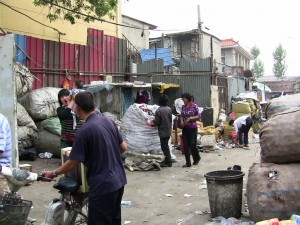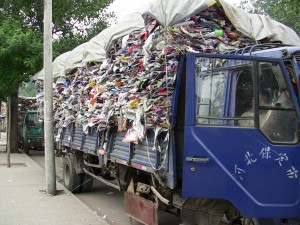The Yin and Yang of GDP and Environment Posted by Stephen on Sep 21, 2011 in Uncategorized

Anyone looking for a lesson in both climate change and sustainability (持续性 chíxùxìng) needs to visit China. In a country full of contradictions or 矛盾 (máodùn), it only makes sense that some of the worse environmental degradation is contrasted by very progressive attempts at conservation and sustainability wherever possible.
China is unique because nowhere else in the world (with a possible exception of India) have we seen such a large population transition from an agrarian society into an industrial one in a mere 30 years (following the Open Door Reform Policy-改革开放 gǎigékāifàng). It’s been truly remarkable watching the speed and efficiency in which China has pursued a path of economic development or 经济发展 (jīng jì fā zhǎn) and ave gobbled up FDI or 以进养出 (yǐjìnyǎngchū). As a result GDP or 国内生产总值 (guónèi shēngchǎn zǒngzhí) has hovered between 9 and 10 percent and is expected to maintain a steady 8 percent for the next decade. To put it plainly, China’s economy is very 厉害 (lì hai)。
But what many eastern philosophies such as Taoism (道教) teach is that contrary forces are often interconnected, much like the 阴阳 (yīn and yáng). As one expands or exerts itself, the other reacts in order to seek balance. With industrial manufacturing and agriculture comes CO2 emissions and pollution and degradation of arable land–all detrimental impacts on the Chinese environment. China’s environment or 环境 (huánjìng) has been taking one for “the team” for a long time. But now it appears the costs of ravaging one’s environment are now spreading to businesses, industries and society in general:
While the numbers do range among Chinese and Western scholars, most predict that the negative externalities associated with environmental degredation (such as land loss, health costs due to air, water, food quality, etc…) remove a substantial chunk of China’s GDP when factored into long term growth (estimates run from 4%-10%, begging the question: is this model sustainable for India and Africa in the future?).
Anyone who’s breathed in air from a major Chinese city or experienced a sandstorm or a “fog advisory” knows just how evident the environmental degradation is in China. Yet, amidst the smoke stacks, coal mines and toxic rivers there’s a silver lining: people are recycling, conserving and developing low cost, common-sense practices and technology to mitigate their environmental impact.

Before my first visit to China, I was unaware of how wasteful westerners (especially Americans) are. In China, electricity and heating are often rationed or decided by strict governmental regulation. Water use, or lack there-of is met with rebates while electricity is self-monitored (bought on rechargeable cards much like cell phones) which really does keep you energy efficient. No light or computer is ever left on when the house is empty and if you live in a northern locale, be prepared to wear many layers or even your jacket while inside the house. It really is a society of “less is more” when it comes to natural resources or 自然资源 (zìrán zīyuán).
What really amazes me about China has to be the recycling or 回收 (huíshōu). While there isn’t really a government run recycling entity as in western countries, it is carried out to near perfection by Chinese citizens looking to scrape together a few bucks. (Click here for previous post on Recycling.) The best part is, anyone can reap the rewards of a recycling economy.
For example, in China (anywhere) you can return around 5-8 bottles of beer to get one free–and all you’d have to do is go outside your apartment to the local market and trade them in. As a result, I took to collecting bottles myself (see below).

Yet if you want to see recycling in full force, there will be at least one recycling hub in the city (our local 老外s deemed it “Apocolyptopolis”) where people make a living obtaining, buying, selling and trading all kinds recycle-able refuse. Here, people are “going green” simply because it makes fiscal sense.
In essence, this is what real grass roots environmentalism is. After talking to a few ”entrepreneurs“ or 企业家 (qǐyèjiā), they explained to me how the costs of materials for plastics and glass are increasing, so selling back recycled goods has a higher price with the same baseline cost of labor and time.(See below: This was just one week’s haul for the self-espoused 企业家人).

Just as the market leaned on the environment, the environment is leaning back on industry, providing cheaper alternatives to non-sustainable growth. Clearly the two are highly interconnected, the question is whether or not China will be able to rebalanced itself in time, finding harmony between industrialized growth and sustainable development before the damage becomes irreversible.
GDP and the environment are now interlinked. China’s future will be determined by how the two find balance with one another.
Follow Steve on twitter: @seeitbelieveit

Build vocabulary, practice pronunciation, and more with Transparent Language Online. Available anytime, anywhere, on any device.
About the Author: Stephen
Writer and blogger for all things China related. Follow me on twitter: @seeitbelieveit -- My Background: Fluent Mandarin speaker with 3+ years working, living, studying and teaching throughout the mainland. Student of Kung Fu and avid photographer and documentarian.




Leave a comment: